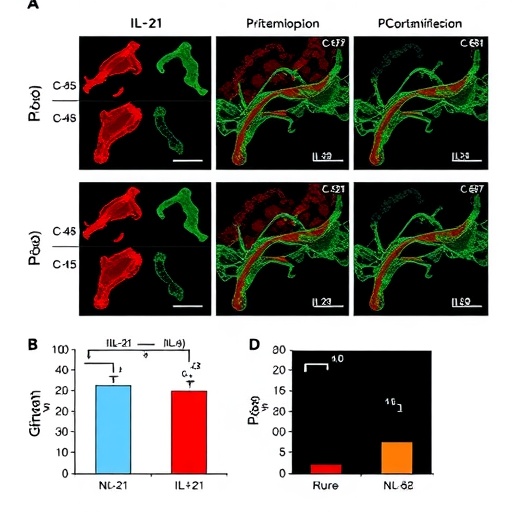
IMAGE: Funerary stele of the priest Rom(a) about 1400BC shows the withered limb and down-flexed foot of poliomyelitis. This artifact is in the Carlsberg ny Glyptothek in Copenhagen, Denmark and is…
Credit: Knowlson et al (2015)
While the goal of polio virus eradication is in sight, there are concerns about post-eradication manufacturing and stockpiling vaccine stores containing live virus that could escape and repopulate the environment. A study published on December 31st in PLOS Pathogens reports the generation of new vaccine strains that appear both effective and unable to cause disease after accidental or intended release.
Different types of polio vaccines currently exist, but none are optimal from a safety point of view. Live attenuated (weakened) vaccine strains carry genetic mutations that prevent them from causing disease, but they can–in rare cases–revert to more dangerous (or virulent) virus. There are also examples in which live attenuated virus can survive in the gut of immune-compromised individuals and can be shed into the environment through their feces. Inactivated vaccines are themselves safe, but their production at present involves growing large amounts of wild-type (i.e., active virulent) virus that is then killed with a chemical called formalin.
After eradication, WHO plans to stop the use of live-attenuated polio vaccines. In addition, to improve safety, WHO has strongly encouraged new manufacturers to switch the source of inactivated virus from virulent wild-type strains to an attenuated strain, named after the polio vaccine pioneer Sabin. Arguing that the attenuated Sabin strain is unstable and therefore potentially problematic, Philip Minor, from the National Institute for Biological Standards and Control in Potters Bar, UK, and colleagues present data on alternative attenuated strains which they propose as a safer alternative source for inactivated vaccine.
The researchers started with a Sabin vaccine strain whose attenuation and reversion has been extensively studied and is well understood. Based on this knowledge, they modified a particular region of the viral RNA in ways that they predicted would make the resulting strains genetically stable (i.e. they would not revert to wild-type or other virulent forms). They then compared these new strains with both the original Sabin vaccine strain and the wild-type strain currently used in the production of inactivated vaccine.
Besides testing the genetic stability of the new strains, the researchers examined their ability to grow in tissue culture (necessary for vaccine production), their risk for causing paralysis in mice engineered to carry a human polio-virus receptor, and whether–after inactivation–they effectively immunized rats. Finally it was shown that these new strains were unable to infect primates by mouth. In all these tests, the new strains behaved as predicted, that is, they are effective, suitable to mass production, and safer than the alternatives.
"We have developed new strains for IPV production with negligible risk to the human population should they escape", the researchers conclude, and add that the attributes of the new strains "allow for safe vaccine production in the post-eradication world."
To address whether the use of new vaccine strains is compatible with WHO's stated post-polio eradication strategy, the researchers state that the current WHO action plan "leaves open the option of assessing new derivatives by an expert panel that will compare the novel strains to the Sabin strains with respect to degree and stability of attenuation, potential for person to person transmission and neurovirulence in animal models to define the containment required which is not specified". The researchers would like their strains assessed in this way. At the very least, they say, this will establish a system for assessment, which they think is necessary.
###
Contact:
Philip Minor
e-mail: [email protected]
phone: +44.(0)17070.641000
Press Office
e-mail: [email protected]
phone: +44.(0)20.3080.7651, or +44.(0)7770.446.189 (out of hours)
Please use this URL to provide readers access to the paper (Link goes live upon article publication):
http://dx.plos.org/10.1371/journal.ppat.1005316
Authors and Affiliations:
Sarah Knowlson, John Burlison, Elaine Giles, Helen Fox, Andrew J. Macadam, Philip D. Minor
Division of Virology, National Institute for Biological Standards and Control, Potters Bar, Hertfordshire, United Kingdom
Please contact [email protected] if you would like more information.
Funding:
This work was supported by NIBSC (National Institute for Biological Standards and Control) through core funding received from the UK Department of Health to fund biological standards and control. The funders had no role in study design, data collection and analysis, decision to publish or preparation of the manuscript.
Competing Interests:
The authors have declared that no competing interests exist.
Citation:
Knowlson S, Burlison J, Giles E, Fox H, Macadam AJ, Minor PD (2015) New Strains Intended for the Production of Inactivated Polio Vaccine at Low-Containment After Eradication. PLoS Pathog 11(12): e1005316. doi:10.1371/journal.ppat.1005316
Media Contact
Philip Minor
[email protected]
44-017-070-641-000





